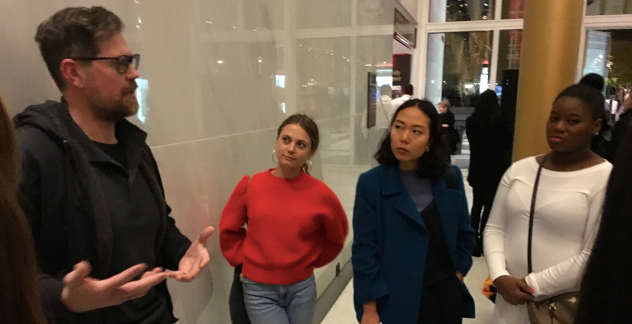Kaitlyn Reynolds (C’21) and Eliza Lafferty (C’20) reflect on Professor Ian Bourland’s “Exiles and Diasporas” Class
What did you learn from the opportunities to engage with local communities, institutions, and sites organized by Prof. Bourland’s ARTH-353: “Exiles and Diasporas” HALC course?
Kaitlyn Reynolds (KR): For one particular project, my classmates and I drove to “Little Saigon”, where we interviewed some of the local community, who told us more about their businesses and culture. I recall feeling like an intruder there, and the class forced me to reflect on why I felt that way. I realized my intentions for speaking to and interviewing the visitors were not immediately clear to them. Now, I try to be more cognizant of the manner in which I interact with the people around me and how they can perceive my intentions.
Eliza Lafferty (EL): In other courses, professors encouraged us to visit museums and attend events. “Exiles and Diasporas” organized attendance and engagement at local museums, cultural centers, and social spheres; our experiences at these institutions inspired deeper classroom conversation and provided opportunities to apply theories to people and places.
Which assignment in the course was most meaningful to you?
EL: One of the most effective projects from “Exiles and Diasporas” was an assignment that encouraged us to trace our own family histories. This project increased buy-in and individual connections to the materials. Additionally, participating in this assignment allowed us to reimagine source materials and discover non-traditional pathways to discovering art. The assignment led me to pursue the issue further and inspired my Art History thesis.
KR: We were asked to visit the African American History Museum and to connect our learning to previous lectures focused on African American art, culture, music, and expression. By examining and discussing the exhibits at the museum, we explored the significance of rap, hip-hop, and R&B to African American communities. We were able to understand the devastating impact of WWI on African American Communities. I found these experiences to be the most effective form of instruction because it brought our academic conversations to life in a palpable way. I felt like I was truly able to connect what we were discussing in the course to my daily life, and it was memorable!
How did “Exiles and Diasporas” challenge you to think differently?
KR: Prof. Bourland encouraged us to step outside our comfort zones and venture into new communities with which many of us were unfamiliar.
EL: The course allowed me to critically apply classroom material to analyze institutions, museums, and power structures. Through visits to cultural enclaves and analysis of community visual cultures, we developed a new praxis.
How did “Exiles and Diasporas” (as a signature HALC course) impact your subsequent studies?
EL: The course’s dynamic and layered approach to studying imagery inspired my senior thesis and provided the lens for analyzing my communities. Additionally, our study of local museums encouraged my professional pursuits and subsequent internship at one of the museums we studied.
KR: Something that I learned from this course that I might not have learned otherwise was how central the deconstruction of African history/ancestry/lineage/culture was to the Slave Trade. As African Americans, we were disconnected from our roots and our past, forced to assume a new identity to which we could never truly commit, and somehow survive all of the following injustices that plagued us following the abolition of slavery with our character still intact. It is truly awe-inspiring, and it is something that I carry in my heart and mind to this day.
